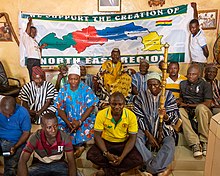Mamprusi people
This article needs additional citations for verification. (October 2017) |
| Regions with significant populations | |
|---|---|
| Languages | |
| Mampruli and French | |
| Religion | |
| Islam |
Mamprusis are an ethnic group in northern Ghana and Togo. Estimates are that there are about 200,000 Mamprusis living in the Northern Regions of Ghana as of 2013.[1] They speak Mampruli, one of the Gur languages. In Ghana, the Mamprusis live mainly in Nalerigu, Gambaga, Walewale, and their surrounding towns and villages in the North East Region. Their origin is in the Upper East Region, principally, Nalerigu, and they also inhabit parts of the Upper West Region.
History
[edit]The Mamprugu Kingdom is one of the oldest Kingdoms in the territory that would afterwards be named The Gold Coast, and subsequently, Ghana.[citation needed] The Mamprusi claim to eldership is based on Cognatic Primogeniture, where succession is through the oldest male child. However, Gbewaa did not practise this, as he designated a younger son Foɣu/Kufoɣu to rule over his eldest child Kachaɣu and his eldest son Zirile.[2][3]

The Kingdom was founded around the 13th century by the Great Naa Gbanwah/Gbewah[4] at Pusiga, a village 14 kilometres from Bawku, which is why Mamprusis revere Pusiga as their ancestral home. Naa Gbanwaah's tomb is in Pusiga.
The Kingdom spans most of the North East, Northern Region of Ghana, portions of Northern Togo, and into Burkina Faso. As a consequence, the King of Mossi, Moronaba, of Burkina Faso, to this day, symbolically, is enskinned by the Nayiri – the king of Mamprugu. Thus, establishing this kingdom as one of the preeminent in the region.[5]
The name of the kingdom is Mamprugu, the ethnicity is Mamprusi, and the language is Mampruli. Succession to a skin is hereditary. Only male direct descendants of Naa Gbanwaah are eligible.[6]
The story of the Mamprusi monarchy traces its origin to a great warrior named Tohazie. Tohazie, means the Red Hunter. He was called the Red Hunter by his people because he was fair in complexion. Tohazie's grandson Naa Gbanwaah settled in Pusiga and established Mamprugu.[7]
Mamprusi is the eldest of the Mõõre-Gurma (Mole—Dagbamba) ethnic group: Mamprusi, Dagomba, Nanumba, and Moshie.[8]
Rulers
[edit]| Tenure | Nayiiri (Mampurugu Naa) (Rulers) |
|---|---|
| c. 1450 | Unknown |
| 1688 to 1742 | Atabia Zontuua |
| 1742 to 1750 | Yamusa Jeringa |
| 17?? to 17?? | Mahaman Kurugu |
| 17?? to 17?? | Sulimani Apisi |
| 17?? to 17?? | Haruna Bono |
| 17?? to 17?? | Andani Yahaya |
| 17?? to 1790 | Mahama Kuluguba |
| 1790 to 1830 | Salifu Saatankugri |
| 1830 to 1833 | Abdurahamani Dambono, (Dahmani Gyambongo) |
| 1833 to 1850 | Dawura Nyongo |
| 1850 to 1864 | Azabu Pagri |
| 1864 to 1901 | Yamusa Barga |
| 1902 to 1905 | Sulimanu Sigri |
| 1906 to 1909 | Ziniya Zore Abduru |
| 1909 to 1915 | Mahami Wubuga |
| 1915 to 1933 | Mahama Waafu |
| 1934 to 1943 | Badimsuguru Zulim |
| 1943 to 1943 | Salifu Salemu |
| 1943 to 1947 | Abudu Soro Kobulga |
| 1947 to 1966 | Abdulai Sheriga |
| 1967 to 1985 | Adam Badimsuguru Bongu |
| 1986 to 1987 | Sulemana Salifu Saa |
| 1987 to 9 June 2003 | Gamni Mohamadu Abdulai |
| 27 January 2004 to present | Bohagu Abdulai Mahami |
Culture
[edit]The majority of the Mamprusi people are adherents of Islam. The Mamprusi began converting to Islam in the 17th century due to the influence of Dyula merchants.[10]
Traditional occupations of the Mamprusi include farming and raising livestock.[11]
References
[edit]- ^ The Diagram Group, ed. (26 November 2013). Encyclopedia of African Peoples. Routledge. p. 590. ISBN 9781135963415.
- ^ "After the death of Naa Gbewaah; the power struggle between Zirli & Kufogu". Sanatu Zambang. 6 January 2020. Retrieved 28 March 2024.
- ^ Abdallah, Zablong Zakariah; Locke, David (2010). "The Lunsi (drummers) of Dagbon: tradition and change". Research Review (21). ISSN 0855-4412.
- ^ Claessen, H. J. M.; Skalník, Peter (1981). The Study of the State. Walter de Gruyter. ISBN 9789027933485.
- ^ Iliasu, A. A. (1975). "The Establishment of British Administration in Mamprugu, 1898-1937". Transactions of the Historical Society of Ghana. 16 (1): 1–28. ISSN 0855-3246.
- ^ "Mamprusi people: Ghana's ancient people in the north". GhanaWeb. 19 July 2020. Retrieved 28 February 2024.
- ^ "Mamprusi people: Ghana's ancient people in the north | News Ghana". newsghana.com.gh/. 19 July 2020. Retrieved 28 February 2024.
- ^ "Yennega pedagogical unit 2 | Women". en.unesco.org. Retrieved 28 February 2024.
- ^ Davis, David C. "'Then the White Man Came with His Whitish Ideas...': The British and the Evolution of Traditional Government in Mampurugu." The International Journal of African Historical Studies, vol. 20, no. 4, 1987, pp. 632. JSTOR 219655. Accessed 31 July 2021.
- ^ Lewis, I. M. (2017). Islam in Tropical Africa. Taylor & Francis. p. 17. ISBN 978-1-138-23275-4.
- ^ Yakan, Mohamad (2017). Almanac of African Peoples and Nations. Routledge. ISBN 978-1-351-28930-6.
Further reading
[edit]- Plissart, Xavier (1983). "Mamprusi Proverbs". Musée Royal de l'Afrique Centrale Annales. 8 (111).
- Drucker-Brown, Susan (1993). "Mamprusi Witchcraft, Subversion and Changing Gender Relations". Africa: Journal of the International African Institute. 63 (4): 531–549. doi:10.2307/1161005. JSTOR 1161005. S2CID 145493870.
- Drucker-Brown, Susan (December 1982). "Joking at Death: The Mamprusi Grandparent-Grandchild Joking Relationship". Man. 17 (4): 714–727. doi:10.2307/2802042. JSTOR 2802042.
- Drucker-Brown, Susan (March 1992). "Horse, Dog, and Donkey: The Making of a Mamprusi King". Man. 21 (1): 71–90. doi:10.2307/2803595. JSTOR 2803595.
External links
[edit]- Autobiography of Alhaji Mumuni Bawumia Launched
- Feature Speaker - Mahamudu Bawumia
- A Life in the Political History of Ghana

